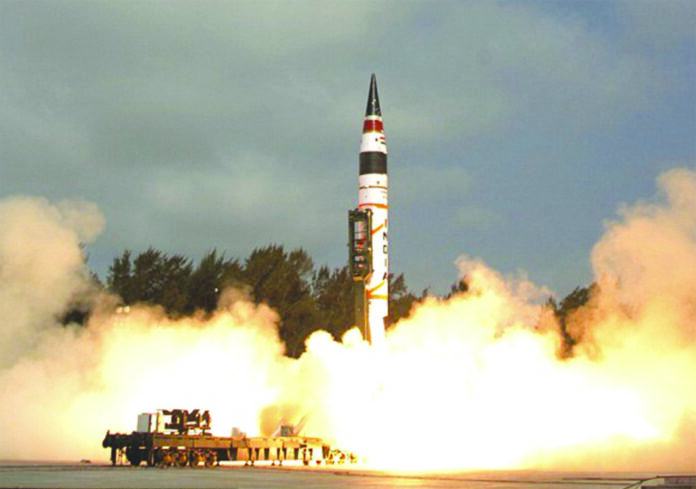India became the seventh nation after the US, UK, France, Russia, Pakistan, and China launched MIRV-armed ballistic missiles when it announced the first flight of an Agni-5 Submarine-launched ballistic missile (SLBM) on March 11. With the ability to carry a nuclear warhead on each independent re-entry, ballistic missiles with MIRVs have a substantially increased potential for destruction. The spread of MIRV capability is a worrying trend in global nuclear arsenals that is already indicating the beginning of a nuclear arms race with increasingly destabilizing MIRV missiles, even though the Indian government may be delighted with its technological accomplishment. The Centre for Arms Control and Non-Proliferation, a non-profit advocacy group located in Washington, states that Pakistan tested MIRV technology in 2017 and that the USA, the United Kingdom, France, China, and Russia are among the nations that now use the MIRV missiles.
The range of the Agni-5 ballistic missile is estimated to reach more than 5,000 km, and possibly even 7,000 km. To strengthen its sea-based deterrence, India will probably use MIRV technology in its K-5 and K-6 SLBMs on board the Arihant-class and the upcoming S5-class ballistic missile submarines (SSBNs) of the Indian Navy, according to Tushar Mangure, a defense analyst at Global Data. India’s deterrence will undoubtedly be strengthened by the Agni-5 missiles, but they will spark a regional nuclear arms race and endanger the lives of almost three billion people.
In January 2017, Pakistan conducted a test flight of a medium-range ballistic missile, called Ababeel, equipped with MIRVs. Three to eight nuclear warheads with various payloads that strike other targets can be carried by it.
India’s MIRV missile test can lead to unrest both inside and outside of the region. The danger it poses to Pakistan and other nearby nations is therefore clearly apparent. India’s military capabilities are still being strengthened. Along with it, India’s claim to be a responsible nuclear state was ruined by a pattern of proliferation and reckless behavior that included incidents of nuclear theft, the diversion of nuclear material supplied for peaceful purposes for military use, the illegal procurement of nuclear materials, and the leakage of centrifuge know-how and also India asserted that on 9 March 2022, one of its BrahMos missiles accidentally landed in Pakistan. India deliberately did not speak with Pakistan in this incident. This move is dangerous and does not reflect the values of responsible nuclear power. The greater concern than the possibility of nuclear conflict is India’s reckless actions as a nuclear state in its quest for prestige. India still hasn’t proven to be a trustworthy US ally, even with backing and exemptions from the USA and the West.
In the light of India’s recent modernization of its nuclear forces and the implications for India’s shift from a counter-value to a counter-force strategy, Pakistan is looking into low-cost ways to maintain the dependability and durability of its nuclear forces while adhering strictly to its Full Spectrum Deterrence policy under the principle of Credible Minimum Deterrence. Ababeel’s MIRV technology can assist Pakistan in breaking into Indian BMD systems and, more importantly, increase the expense of a full first-strike capability.
Due to the missiles’ potential to carry nuclear warheads and be able to reach beyond Pakistan and China to target other parts of the world, India’s possession of nuclear-capable long-range intercontinental ballistic missiles (ICBMs) is a major source of instability in the region and beyond. India’s military buildups threaten strategic stability in South Asia and raise the possibility of nuclear escalation outside the region, a threat that the USA and its allies must realize.
Along with this, it appears much more risky than our existing geostrategic environment to live in a world where almost all nuclear-armed nations have significant MIRV capacity. This is because MIRVs have the potential to be both attractive first-strike targets and highly devastating first-strike weapons due to their tremendous destructive capabilities. Widespread MIRV deployments would not only exacerbate the world’s nuclear arms race by strengthening plans for worst-case force postures, but they would also significantly weaken crisis stability by encouraging governments to rapidly deploy their nuclear weapons in an emergency.
Due to their upgraded MIRV capabilities, India and Pakistan will have far larger nuclear arsenals. Each nation might add hundreds more warheads to their ballistic missile systems, which are already advanced. Thus, employing MIRVs would be consistent with a plan to hit several targets at once and run the risk of sparking a race for warheads between Pakistan and India. The credibility of Pakistan’s and India’s minimum deterrence doctrines would be placed into uncertainty if MIRVs were deployed.
In the light of India’s recent modernization of its nuclear forces and the implications for India’s shift from a counter-value to a counter-force strategy, Pakistan is looking into low-cost ways to maintain the dependability and durability of its nuclear forces while adhering strictly to its Full Spectrum Deterrence policy under the principle of Credible Minimum Deterrence. Ababeel’s MIRV technology can assist Pakistan in breaking into Indian BMD systems and, more importantly, increase the expense of a full first-strike capability.






















